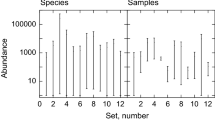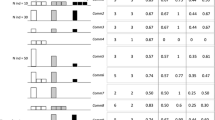Abstract
Quantifying a relative abundance distribution based on thesampling of a set of species is a widespread problem in ecology.A number of diversity indices have been proposed and used in numerous works in spite of a lack of statistical characteristics and tests of comparison. The relative abundancedistribution can also be described using rank-frequency diagrams but fitting these diagrams to mathematical models such as the Zipf-Mandelbrot model remains problematic. Strong correlation between the Zipf-Mandelbrot model parameters prevent their estimation by optimization algorithm. In light of this, new indices of sampled communities are introduced here. These indices are two linear regression slopes estimated from rank-frequency diagrams. The numerous statistical studies that have been carried out on linear regression models are used to compare sampled communities. These new indices possesscharacteristic properties with an ecological meaning.Correlations between these indices, the Zipf-Mandelbrot modelparameters and an evenness diversity index are examined. Anecological application is made using entomological data as anexample. This example consists of a transect from the edge of apond to a dry forest along which 60,000 insects were sampledfrom six different sampling stations. Using the new indicesdescribed here, station C, located at the edge of that areasubject to influence from the pond, is differentiated from theother stations. This station would seem to present the lowestdegree of niche diversity and the lowest evenness, and recent observations confirm the deterioration of this station.
Similar content being viewed by others
References
Altesor, A., Di Landro, E., May, H. and Ezcurra, E.: 1998, Long-term species change in a Uruguayan grassland, J. Veget. Sci. 9, 173-180.
Aoki, I.: 1995, Diversity and rank-abundance relationship concerning biotic compartments, Ecol. Modelling 82, 21-26.
Bach, P., Amanieu, M., Lam Hoi, T. and Lasserre, G.: 1998, Application du modéle de distribution d'abondance de Mandelbrot à l'estimation des captures dand l'étang de Thau, J. Cons. Int. Explo. Mer 44, 235-246.
Bersier, L. F. and Sugihara, G.: 1997, Species abundance pattern: the problem of testing stochastic models, J. Amin. Ecol. 66, 769-774.
Burel, F., Baudry, J., Butet, A., Clergeau, P., Delettre, Y., Le Coeur, D., Dubs, D., Morvan, N., Paillat, G., Petit, S., Thenail, C., Brunel, E. and Lefeuvre, J.C.: 1998, Comparative biodiversity along a gradient of agricultural landscapes, Acta Oecol. 19(1), 47-60.
Camargo, J. A.: 1996, Spatiotemporal variations in species diversity to assess environmental impacts on aquatic communities: the use of biomass data versus density data, Environ. Monit. Assess. 34, 271-287.
Coleman, N., Gason, A. S. H. and Poore, G. C. B.: 1997, High species richness in the shallow marine waters of south-east Australia, Mar. Ecol. Prog. Ser. 154, 17-26.
Draper, N. R. and Smith, H.: 1966, Applied Regression Analysis, Wiley and Sons, New York, 256 pp.
Elliott, J. M.: 1977, Some methods for the statistical analysis of samples of benthic invertebrates, Scientific Publications of the Freshwater Biological Association, Ambleside, UK, 153 pp.
Franklin, J. F.: 1988, Structural and functional diversity in temperate forests, in E. O. Wilson (ed.), Biodiversity, National Academy Press, Washington, pp. 166-175.
Fromentin, J. M., Dauvin, J. C., Ibanez, F., Dewarumez, J. M. and Elkaim, B.: 1997, Long-term variations of four macrobenthic community structures, Oceanol. Acta 20(1), 43-53.
Frontier, S.: 1976, Utilisation des diagrammes rang-fréquence dans l'analyse des écosystèmes, J. Rech. Ocean. 1, 35-48.
Frontier, S.: 1985, Diversity and structure in aquatic ecosystems, Mar. Biol. Ann. Rev. 23, 253-312.
Gaston, K. J.: 1994, Rarity, Chapman and Hall, London, 192 pp.
Gaston, K. J.: 1996, Biodiversity, Blackwell, Oxford, 395 pp.
Gaston, K. J. and Mound, L. A.: 1993, Taxonomy, hypothesis testing and the biodiversity crisis, Proc. Roy. Soc. Lon. B. 251, 139-142.
Gimaret-Carpentier, C., Pélissier, R., Pascal, J. P. and Houllier, F.: 1998, Sampling strategies for the assessment of tree species diversity, J. Veget. Sci. 9, 161-172.
Hughes, R. G.: 1986, Theories and models of species abundance, Amer. Nat. 128, 879-899.
Hutcheson, K.: 1970, A test for comparing diversities based on the Shannon formula, J. Theor. Biol. 29, 151-154.
Kevan, P. G., Greco, C. F. and Belaoussoff, S.: 1997, Log-normality of biodiversity and abundance in diagnosis and measuring of ecosystemic health: pesticide stress on pollinators on blueberry heaths, J. Appl. Ecol. 34, 1122-1136.
Lam Hoi, L., Amanieu, M. and Lasserre, G.: 1984, Notes sur l'ajustement du modèle de distribution d'abondances de Mandelbrot par la méthode des moindres carrés non linéaires, Acta Oecol. 5, 159-167.
Leps, J.: 1993, Taylor' power law and the measurement of variation of the size of populations in space in time, Oïkos 68, 349-356.
Ludwig, J. A. and Reynolds, J. F.: 1988, Statistical Ecology. A Primer on Methods and Computing, Wiley, New-York, 337 pp.
Macchiato, M. F., Ragosta, M., Cosmi, C. and Lo Porto, A.: 1992, A method in multivariate statistics to analyze ecosystems starting from their species composition, Ecol. Modelling 62, 285-310.
Magurran, A. E.: 1988, Ecological Diversity and its Measurements, Princeton University Press, Princeton, 179 pp.
Mandelbrot, B.: 1977, Fractals, Form, Chance and Dimension, Freeman and Co, San Francisco.
Mandelbrot, B.: 1982, The Fractal Geometry of Nature, Freeman and Co, San Francisco.
McArthur, R. H.: 1957, On the relative abundance of species, Proceedings of the National Academy og Sciences of the USA 43, 283-295.
Miller, J. C.: 1993, Insect natural history, multi-species interactions and biodiversity in ecosystems, Biodiv. Conserv. 2, 233-241.
Motomura, I.: 1947, Further notes on the law of geometrical progression of the population density in animal association, Physiol. Ecol. 1, 55-60.
Naeem, S. and Hawkins, B. A.: 1994, Minimal community structure: How parasitoids divide resources, Ecology 75(1), 79-85.
Noss, R. F.: 1990, Indicators for Monitoring Biodiversity: A Hierarchical Approach, Concer. Biol. 4(4), 355-364.
Patil, G. P. and Taillie, C.: 1982, Diversity as a concept and its measurement, J. Am. Stat. Ass. 77, 548-561.
Peet, R. K.: 1975, Relative diversity indices, Ecology 56, 496-498.
Pielou, E. C.: 1966, Shannon' formula as a measure of specific diversity: its use and misuse, Amer. Nat. 100, 463-465.
Pielou, E. C.: 1969, An Introduction to Mathematical Ecology, Wiley-Interscience, New York, 320 pp.
Pielou, E. C.: 1975, Ecological Diversity, Wiley Interscience, New-York, 165 pp.
Preston, F. W.: 1948, The commonness and rarity of species, Ecology 29, 254-283.
Preston, F. W.: 1962, The canonical distribution of commonness and rarity, Ecology 39, 185-215.
Qinghong, L.: 1995, A model for species diversity monitoring at community level and its applications, Environ. Monit. Assess. 34, 271-287.
Roth, M. and Couturier, G.: 1966, Les plateaux colorés en écologie entomologique, Annals de la Société Entomologique de France 2, 361-370.
Smith, W. K.: 1989, ANOVA-like similarity analysis using expected species shared, Biometrics 45, 873-881.
Somerfield, P. J. and Clarke, K. R.: 1995, Taxonomic levels in marine communities revisited, Mar. Ecol. Prog. Ser. 127, 113-119.
Snedecor, G. W. and Cochran, W. G.: 1967, Statistical Methods, Ames, Iowa, 503 pp.
Soulé M. E. and Wilcox, B. A.: 1980, Conservation Biology, Sinauer, Sunderland, 395 pp.
Southwood, T. R. E.: 1978, Ecological methods with particular reference to the study of insects populations, Chapman and Hall, London, 524 pp.
Spellerberg, I. F.: 1991, Monitoring Ecological Change, University Press, Cambridge.
Tilman, D. and Downing, J. A.: 1994, Biodiversity and stability in grasslands, Nature 367, 363-365.
Tokeshi, M.: 1990, Niche apportionment or random assortment: species abundance patterns revisited, J. Anin. Ecol. 59, 1129-1146.
Tokeshi, M.: 1993, Species Abundance Patterns and Community Structure, Adv. Ecol. Res. 24, 111-186.
Turner, M. G. and Gardner, R. H.: 1991, Quantitative Methods in Landscape Ecology, Springer-Verlag, New-York, 458 pp.
Weither, E. and Boylen, C. W.: 1994, Patterns and prediction of alpha and beta diversity of aquatic plants in Adirondack lakes, Can. J. Bot. 72, 1797-1804.
Williams, P. H. and Gaston, K. J.: 1994, Measuring more of biodiversity: can higher-taxon richness predict wholesale species richness? Biol. Conserv. 67, 211-217.
Wilson, J. B.: 1991, Methods for fitting dominance/diversity curves, J. Veget. Sci. 2, 35-46.
Wilson, J. B. and Citay, S. H.: 1995, Community structure and assembly rules in a dune slack: Variance in richness, guild proportionality, biomass constancy and dominance/diversity relations, Vegetatio 116, 93-106.
Wilson, J. B., Wells, T. C. E., Trueman, I. C., Jones, G., Atkinson, M. D., Crawley, M. L., Dodd, M. E. and Silvertown, J.: 1996, Are there assembly rules for plant species abundance? An investigation in relation to soil resources and successional trends, J. Ecol. 84, 527-538.
Wilson, J. B., Gitay, H., Steel, J. B. and King, W. M.: 1998, Relative abundance distributions in plant communities: effects of species richness and of spatial scale, J. Veget. Sci. 9, 213-220.
Zar, J. H.: 1984, Biostatistical analysis, Prentice-Hall International Editions, Englewood Cliffs, 718 pp.
Zipf, G. K.: 1965, Human behavior and principle of least effort, Addison-Wesley, Cambridge and Hefner, New York, 195 pp.
Author information
Authors and Affiliations
Corresponding author
Rights and permissions
About this article
Cite this article
Mouillot, D., Lepretre, A. Introduction of Relative Abundance Distribution (RAD) Indices, Estimated from the Rank-Frequency Diagrams (RFD), to Assess Changes in Community Diversity. Environ Monit Assess 63, 279–295 (2000). https://doi.org/10.1023/A:1006297211561
Issue Date:
DOI: https://doi.org/10.1023/A:1006297211561




